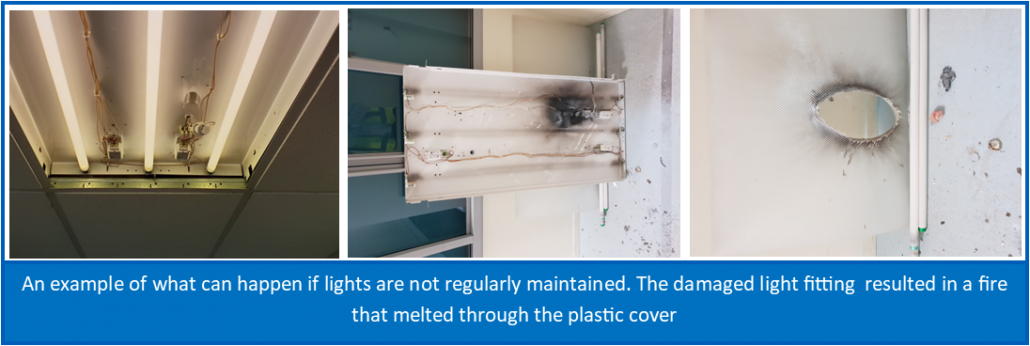ESSENTIAL MAINTENANCE FOR FLUORESCENT & HIGH INTENSITY DISCHARGE LIGHTS
All electrical products generate heat and therefore have the potential to be a fire risk if not properly maintained. Worksafe have highlighted in this months’ newsletter in conjunction with the Lighting Council the need to ensure that Fluorescent and High Intensity Discharge (HID) light fittings are being regularly maintained due to the number of fire related incidents they have been involved in recently.
Most fluorescent and HID lights supplied and installed in New Zealand over the past 30 years contain replaceable power factor correction capacitors. Regular maintenance including checking and replacing aged components is essential to ensure they operate safely and efficiently. HID type lights include metal halide, high pressure sodium and mercury vapour technologies.
Proper maintenance of any lighting system is essential to maintain levels of illumination necessary for productivity, merchandising, visual comfort, safety, and security. However, Worksafe’s key concern in highlighting the need for this essential maintenance is the increased risk of failure and fire these lights pose if not regularly maintained.

If an individual component fails and remains in the lighting system, costly damage to other components can result. Major repairs can often be avoided by simple maintenance procedures and timely attention to small problems, such as replacing burned-out lamps. Preventing a problem from occurring is more desirable and economical than fixing it later. A scheduled program of preventive maintenance can save money while maintaining productivity and safety.
EAS recommends the following servicing of fluorescent and HID lights to ensure best performance and safety:
- Lights should be serviced at least every three years and whenever fluorescent tubes and HID lamps are replaced.
- HID lighting fixtures should periodically be inspected for lamps cycling on and off, heavy
lamp discoloration, dim lamps, slow-starting lamps, inoperative lamps and dust and dirt. - When any capacitors, ballasts, lamp holders or starters show signs of ageing. These should be replaced immediately.
- Capacitors have a life span of five to ten year. These must be replaced within the 10 year period.
- A maintenance record of the components, the dates they’ve been checked and the dates that any components have been replaced should be
kept. EAS can assist you with establishing and maintaining a maintenance record for
your lighting. - Any lights that are subject to high ambient or external heat will require more regular checks and maintenance. EAS recommends a six monthly check for these lights.
EAS can coordinate the whole process of maintaining and installing your fluorescent and HID lighting. Ensure your lights are safe by getting in touch with the EAS team for a maintenance check today on 07 834 0505 or [email protected].

Leave a Reply
Want to join the discussion?Feel free to contribute!